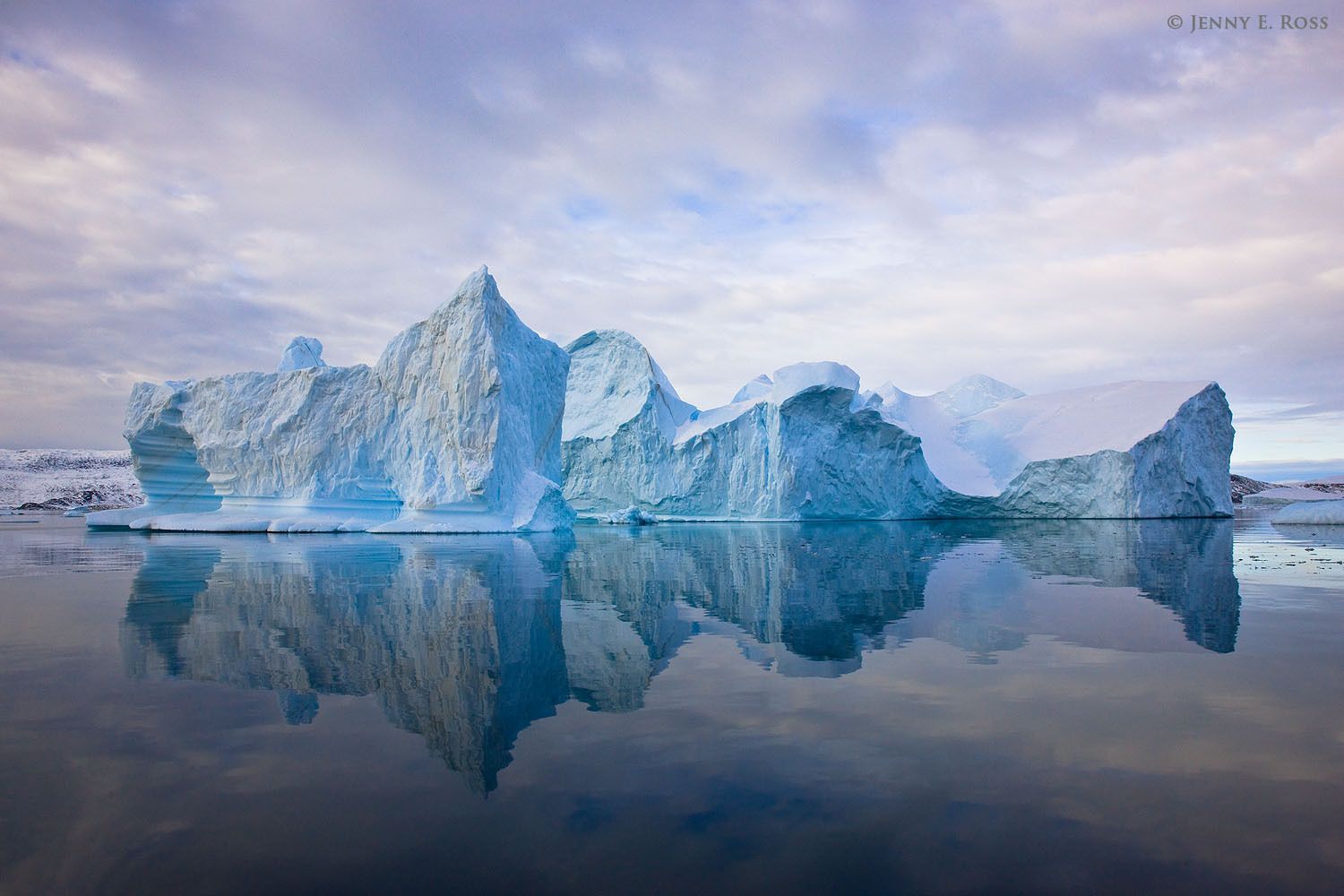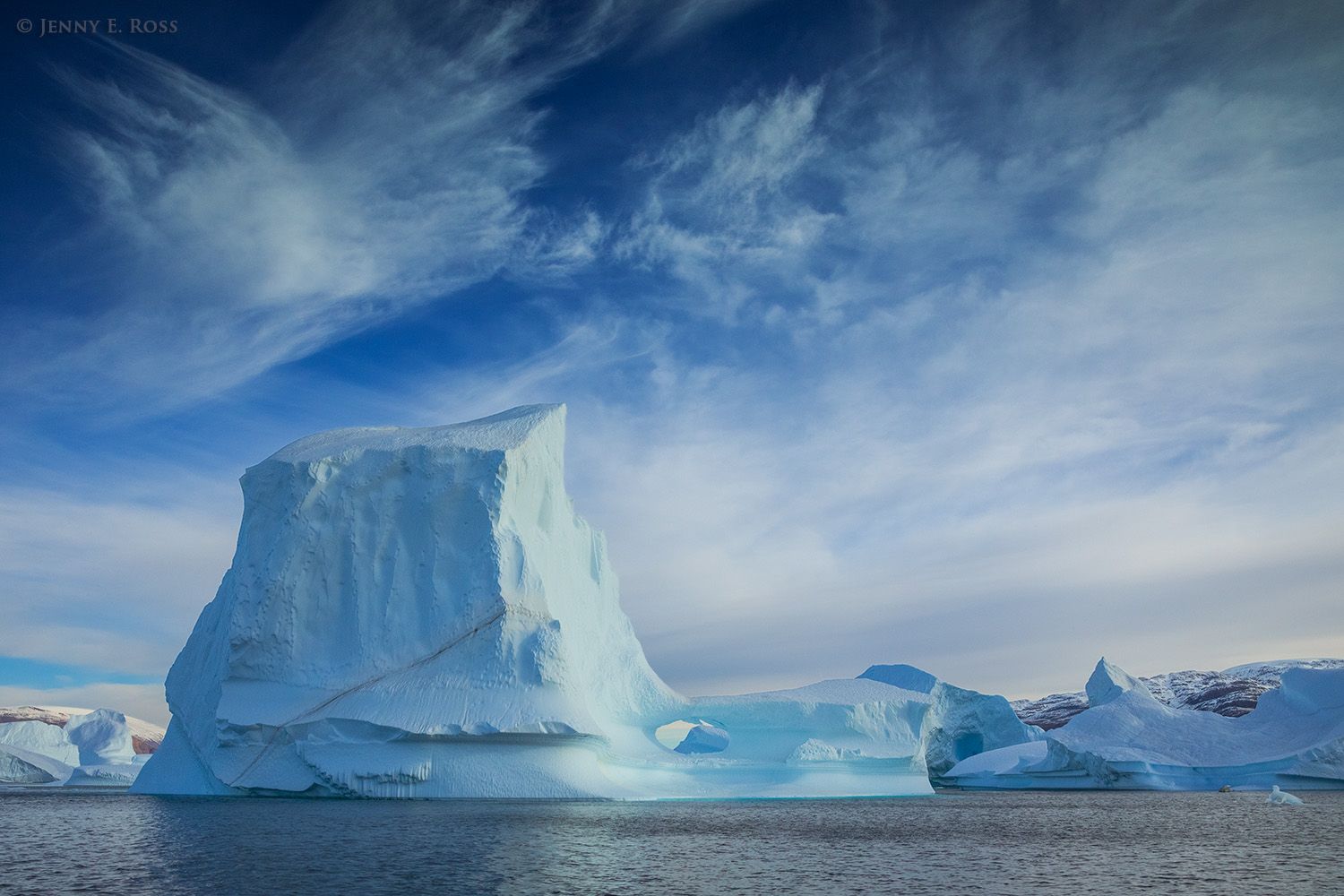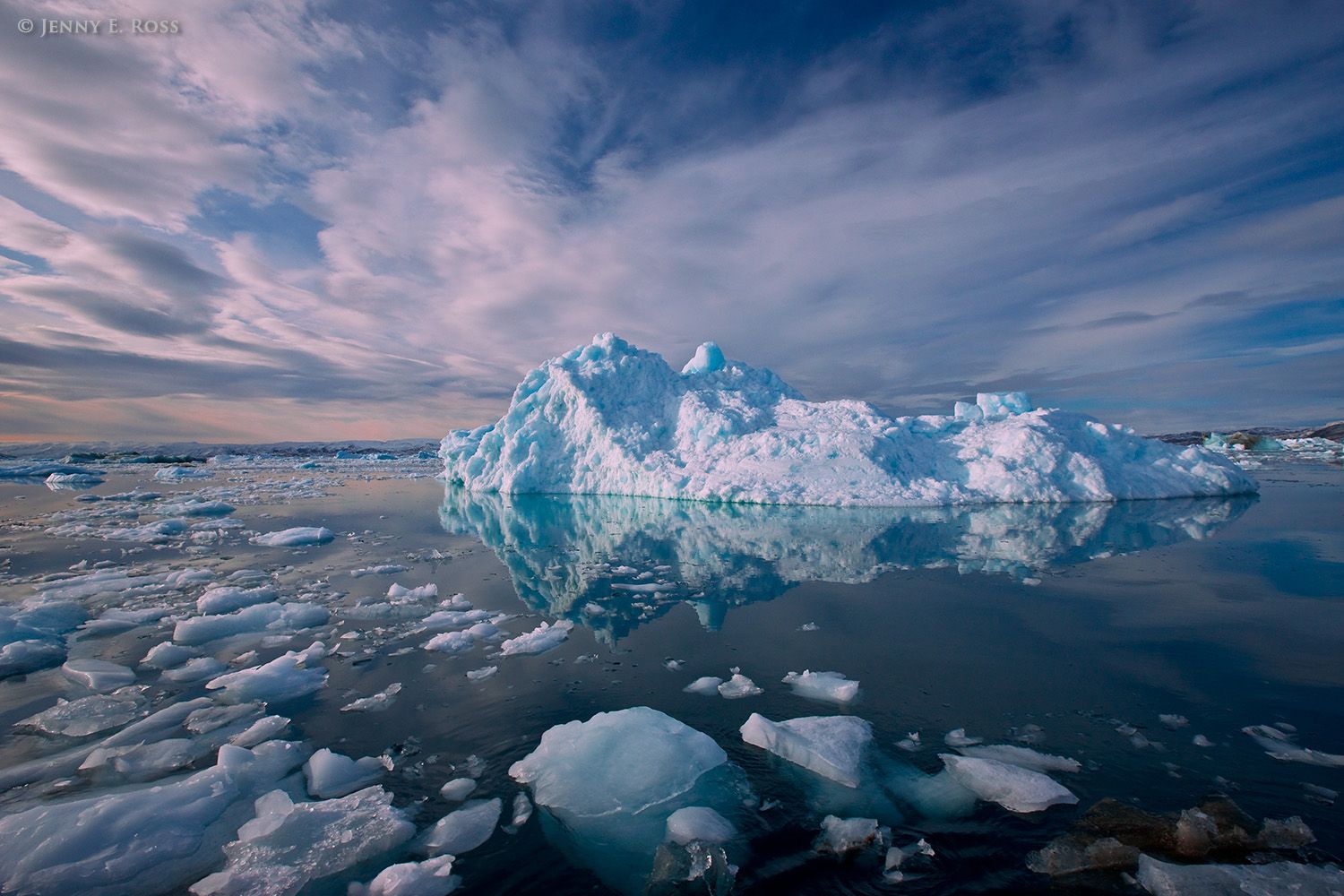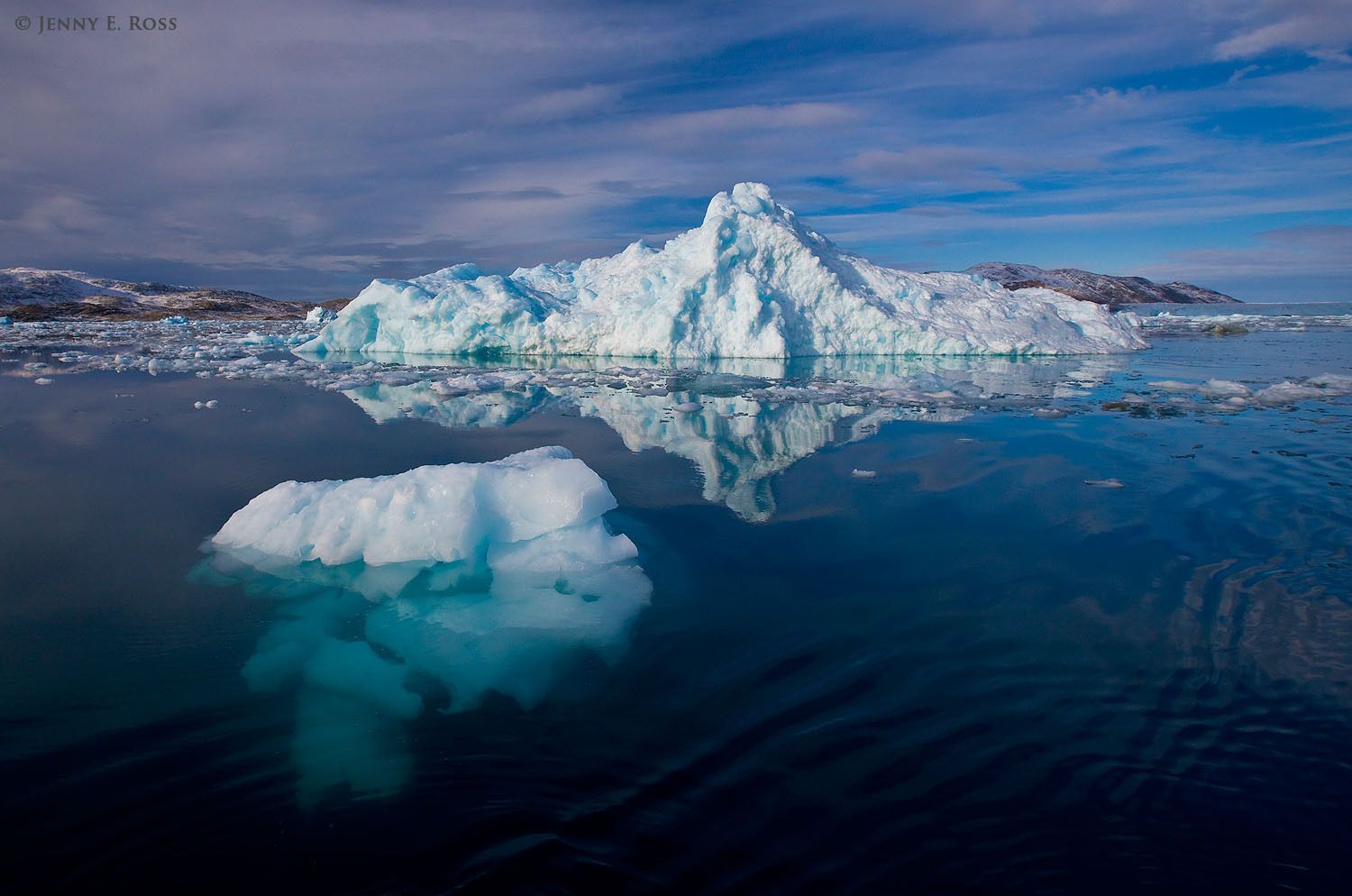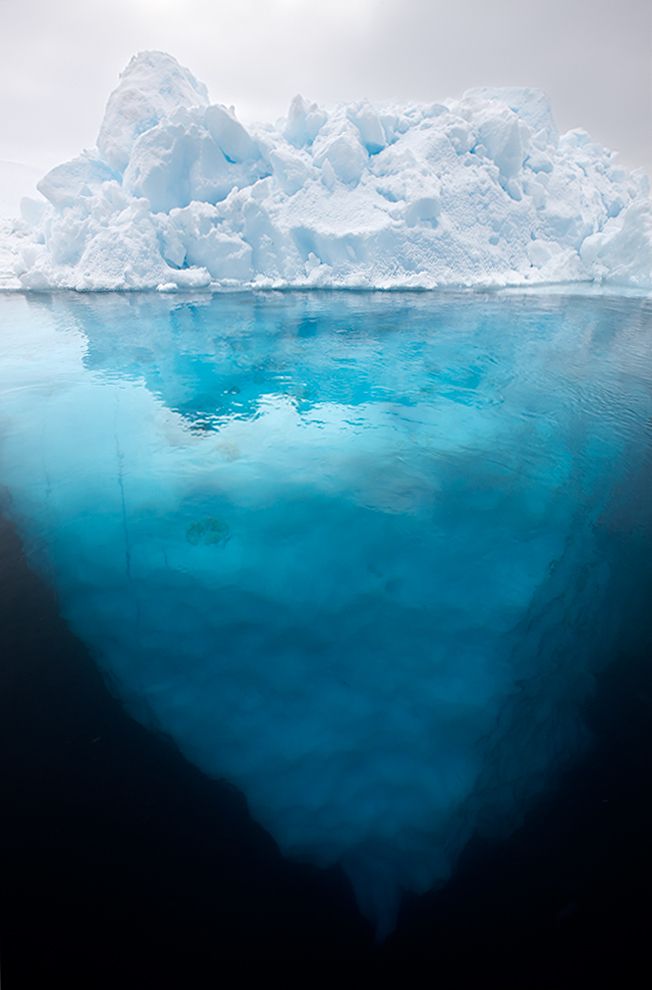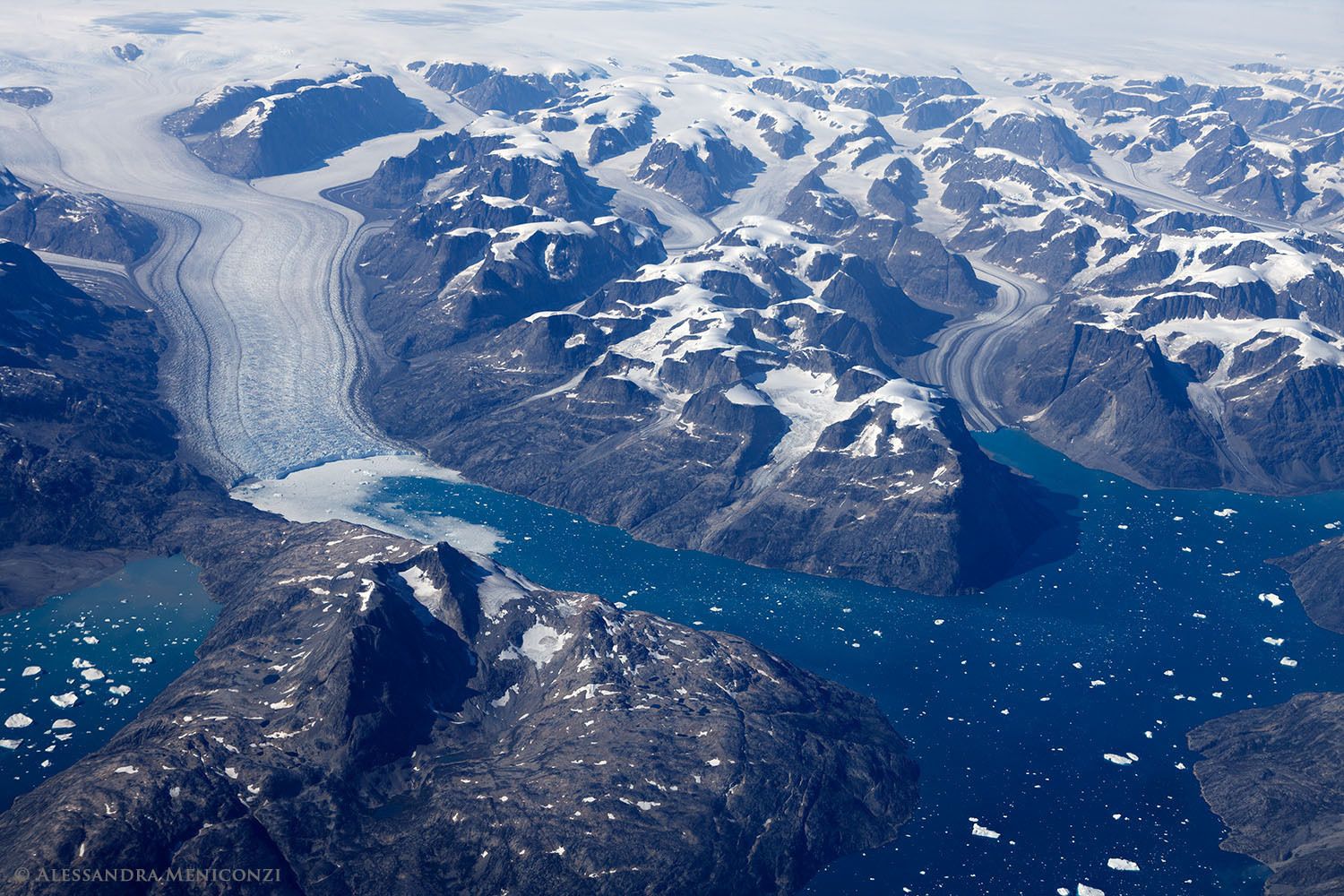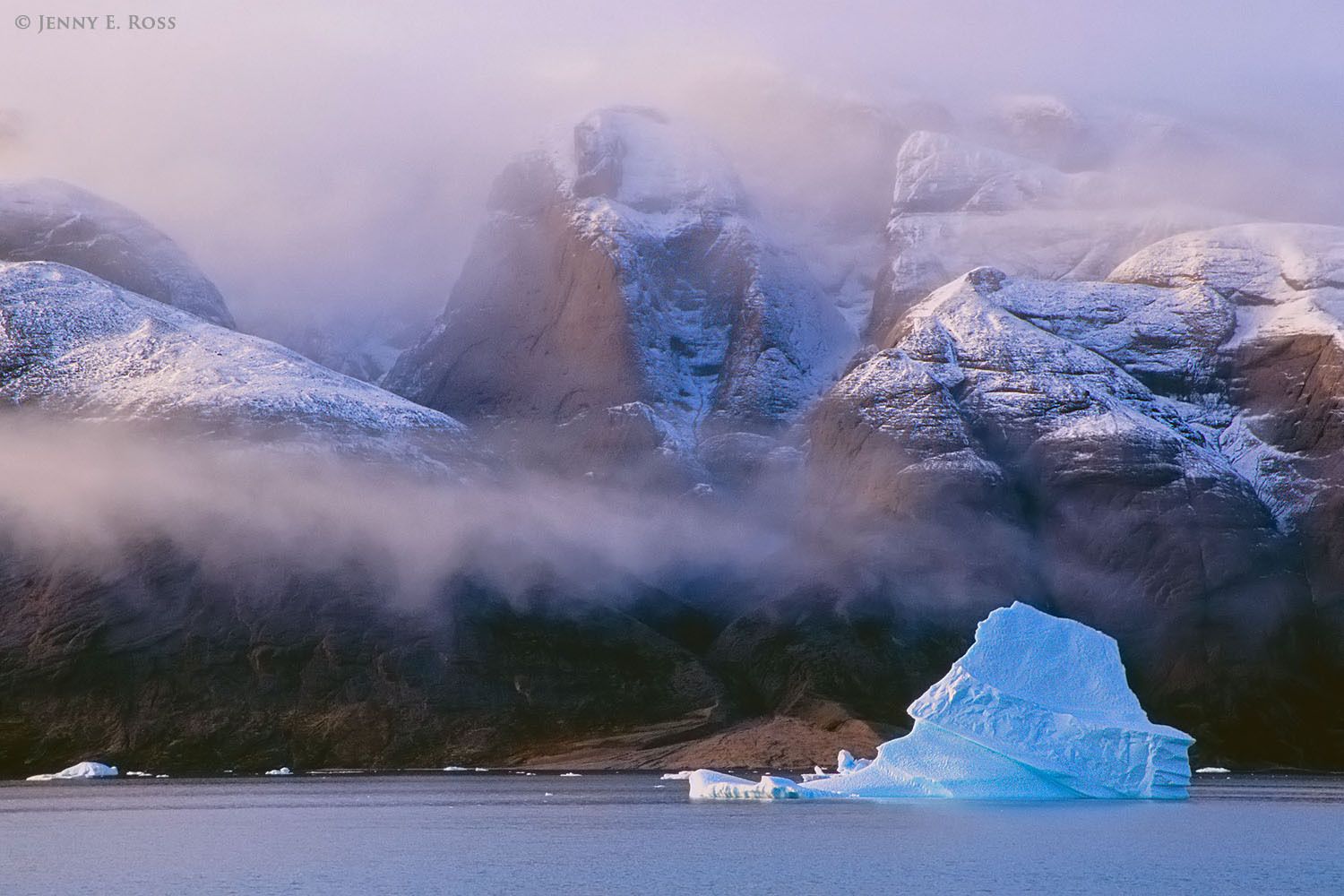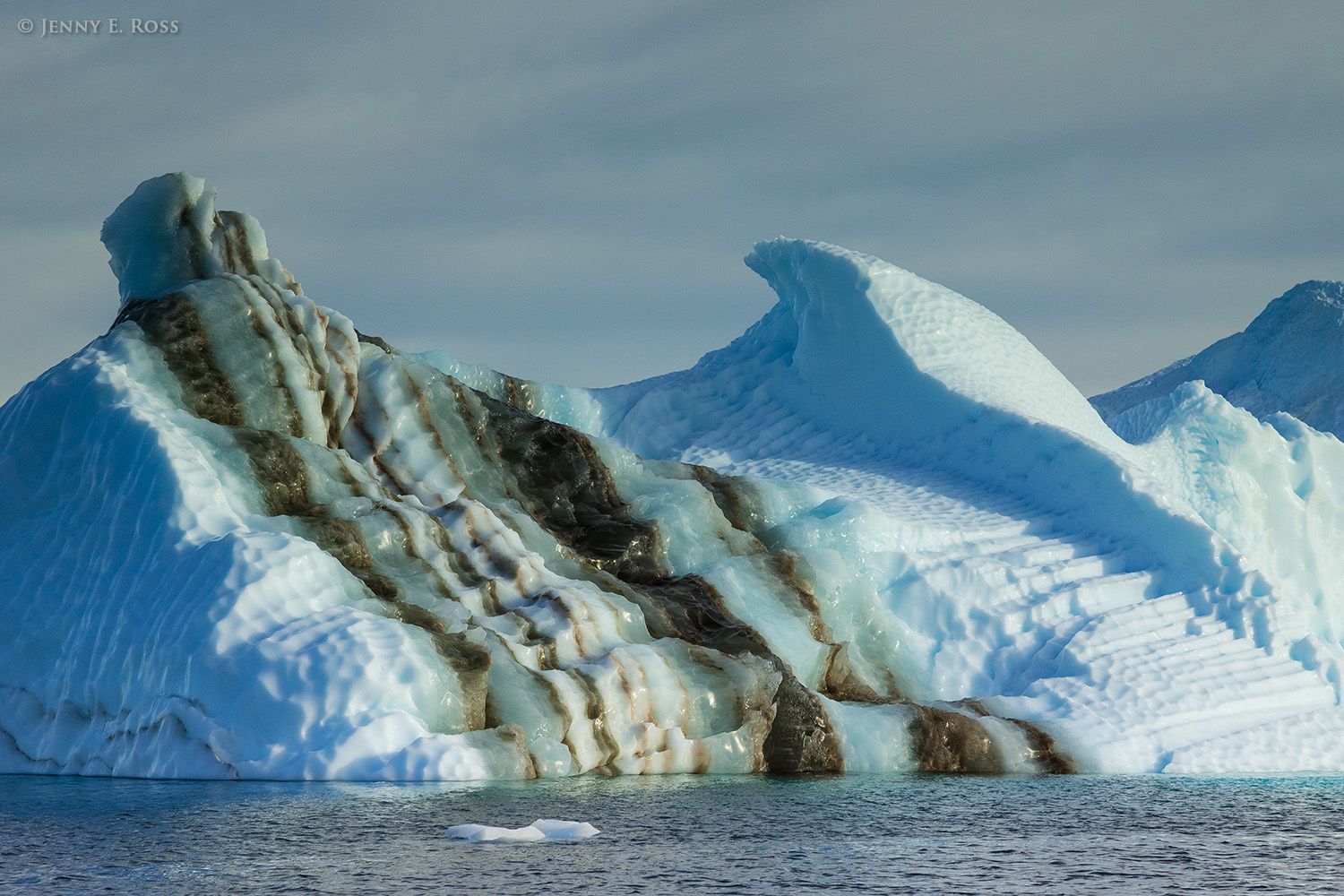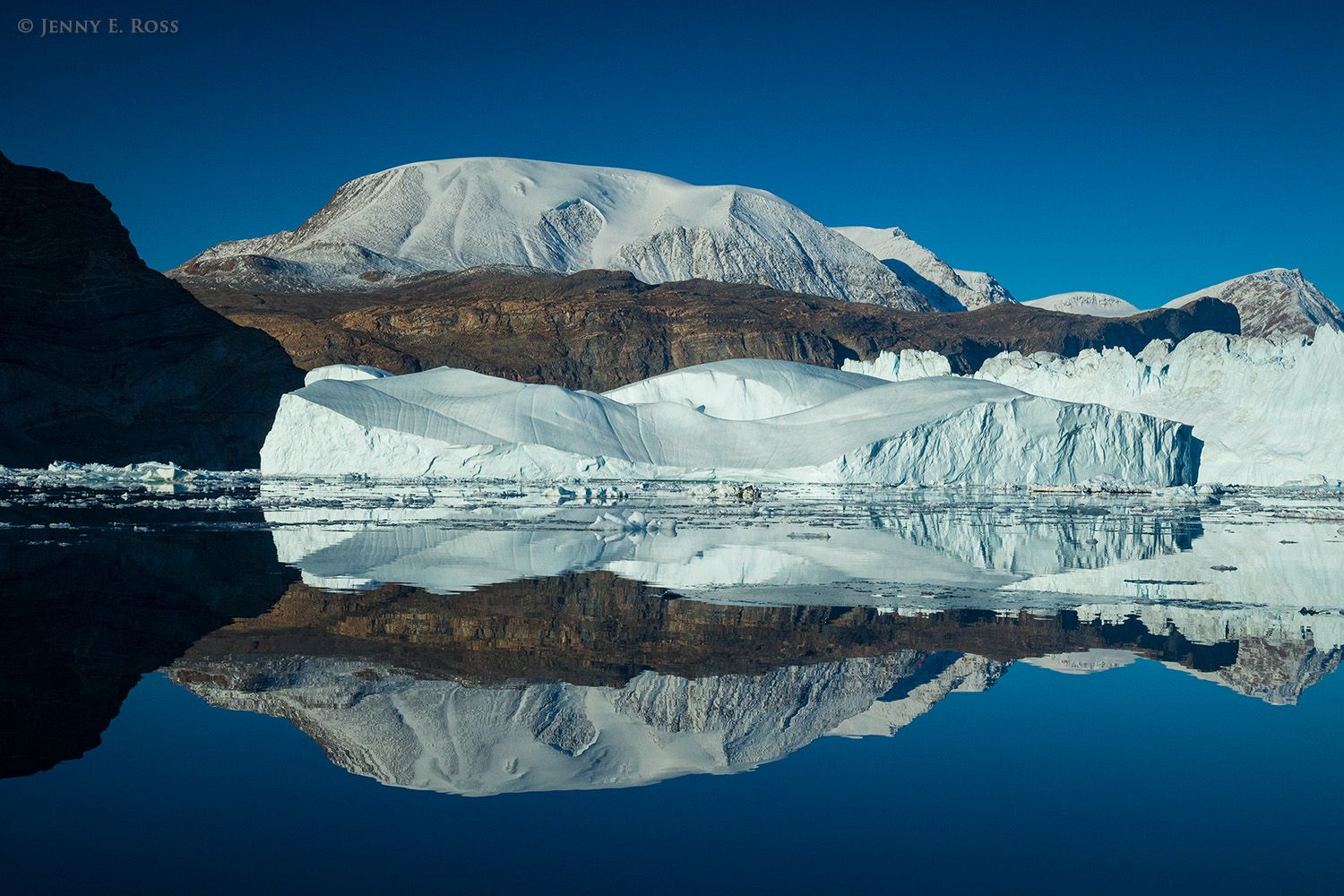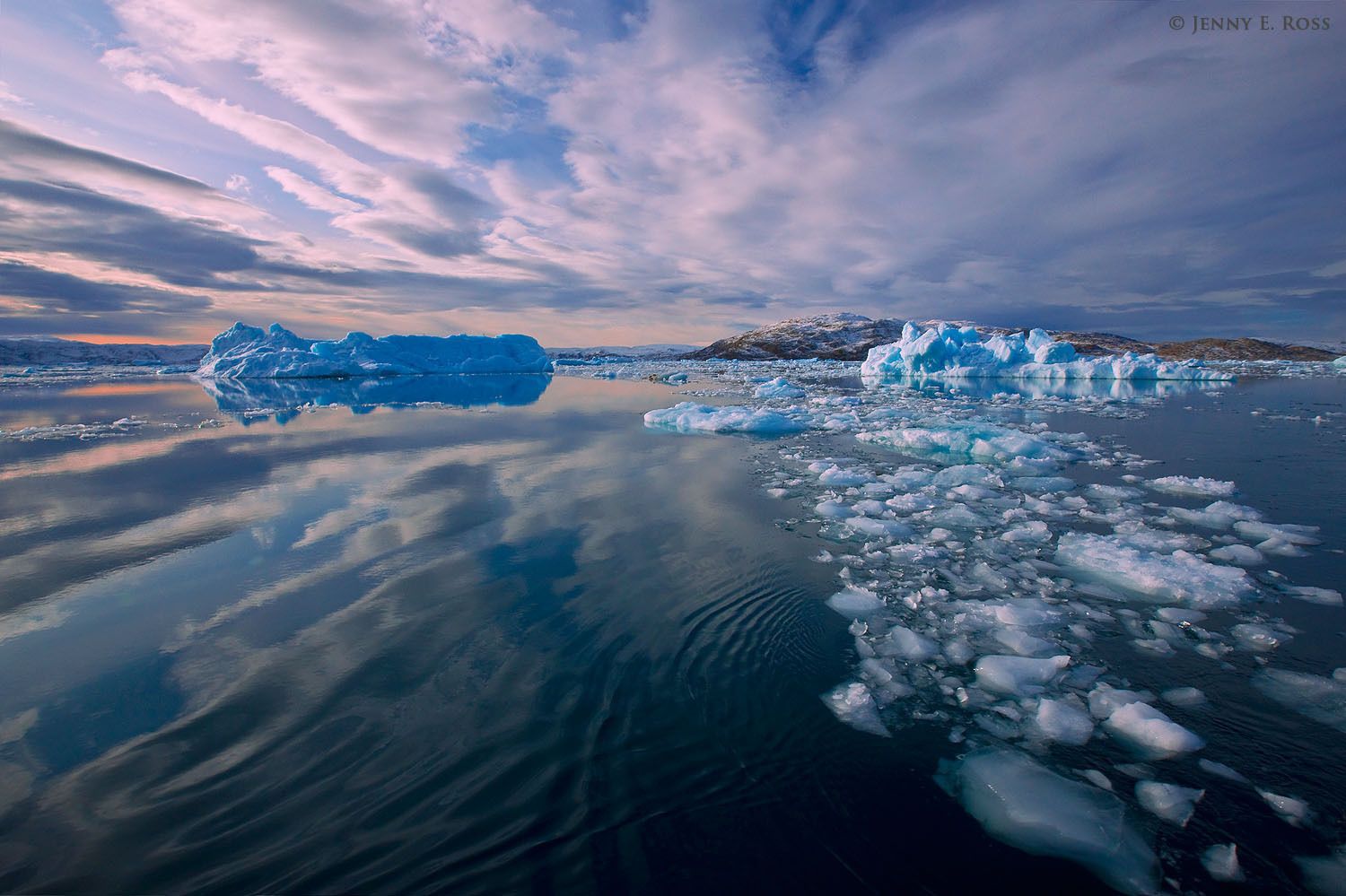-
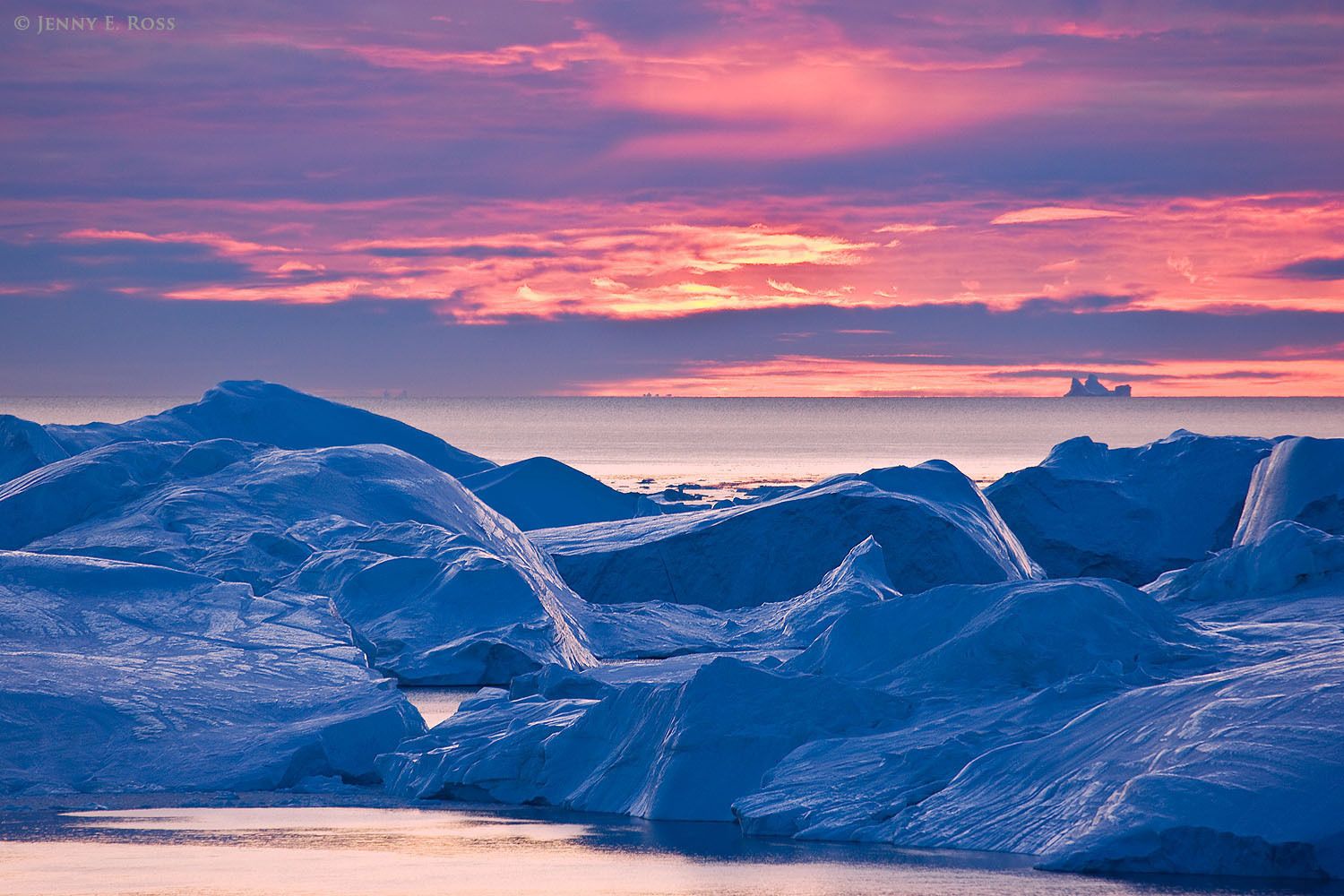
Immense melting icebergs at Isfjeldbanken (the Iceberg Bank), Ilulissat Icefjord, Disko Bay, West Greenland.
Sunset illuminates icebergs, produced by the Jakobshavn Isbrae glacier, that are stranded temporarily on Isfjeldbanken at the mouth of the Ilulissat Icefjord in West Greenland. The immense Jakobshavn Isbrae (also known as Sermeq Kujalleq), flows from the Greenland Ice Sheet into the Ilulissat Icefjord and is one of the fastest-moving, most productive, and most quickly receding glaciers in the northern hemisphere. The calved ice eventually moves into the Atlantic Ocean, where it melts and raises sea level. The Ilulissat Icefjord was designated as a UNESCO World Heritage Site in 2004.
-
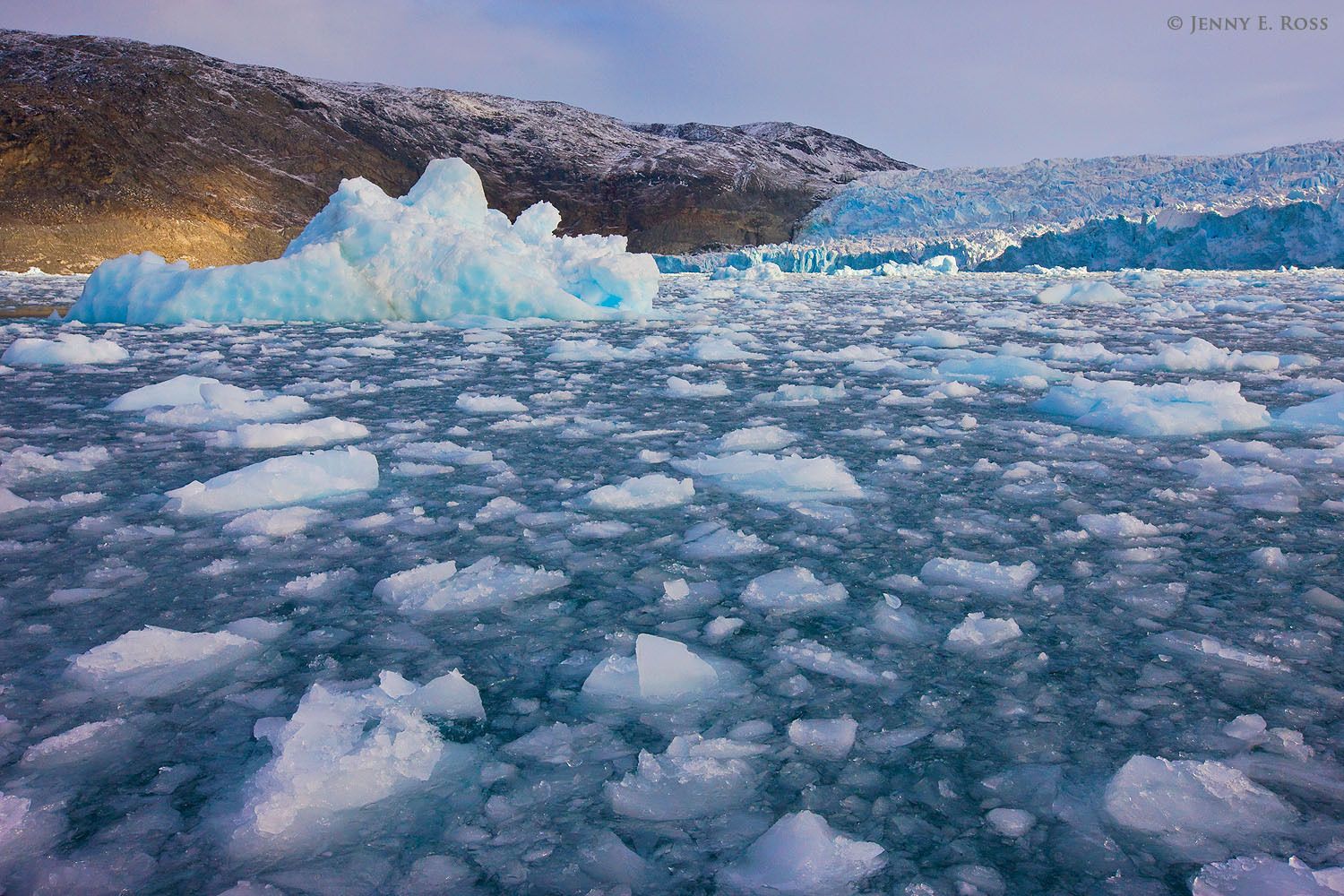
Icebergs and brash ice at Eqip Sermia Glacier, West Greenland.
-
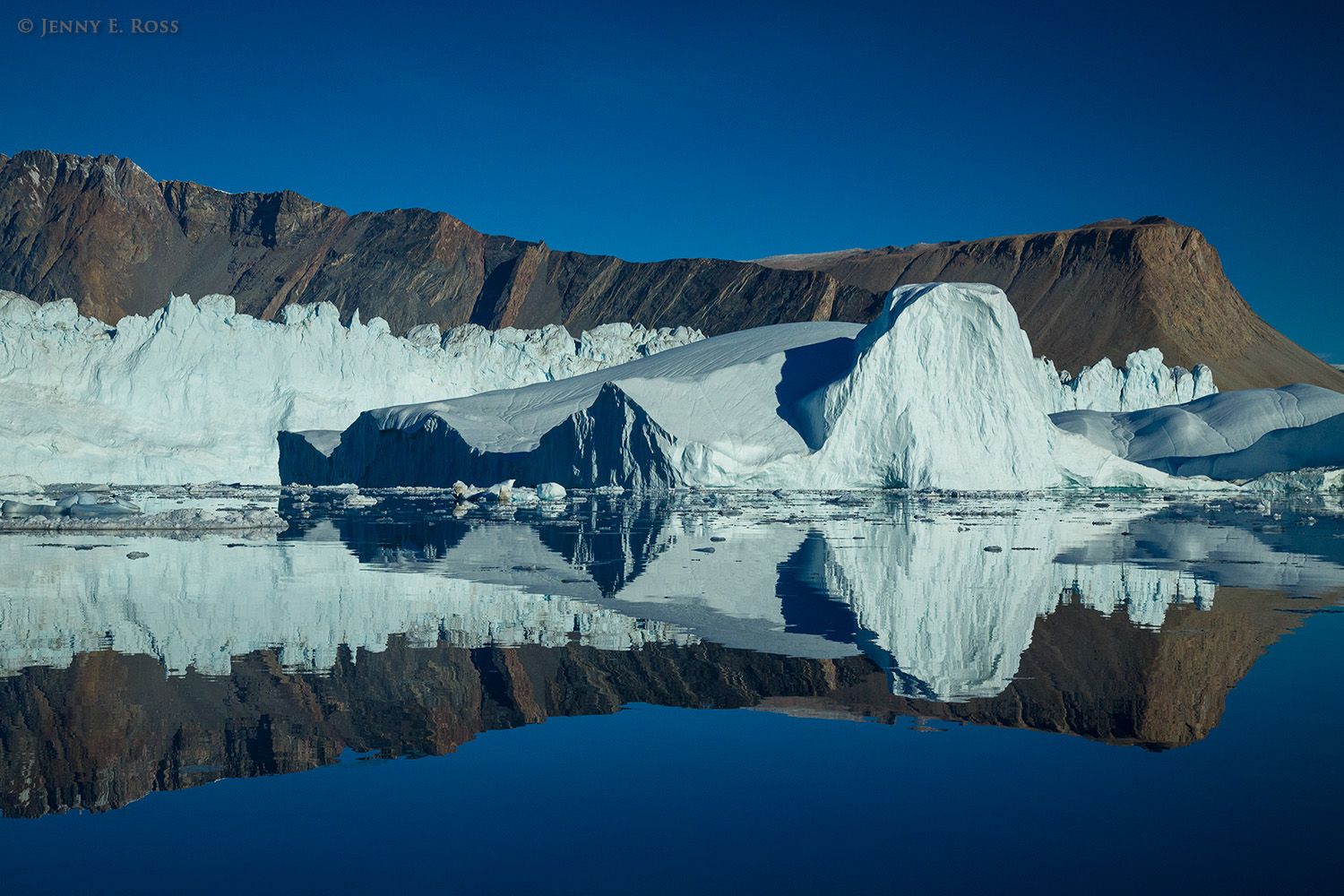
Icebergs, ancient metamorphosed sedimentary rock, and Daugaard-Jensen Glacier are reflected in the still water of Norvest Fjord in Scoresby Sund, Northeast Greenland National Park, Northeast Greenland.
Scoresby Sund, which is connected to the Greenland Sea, has the largest and longest fjord system in the world.
-
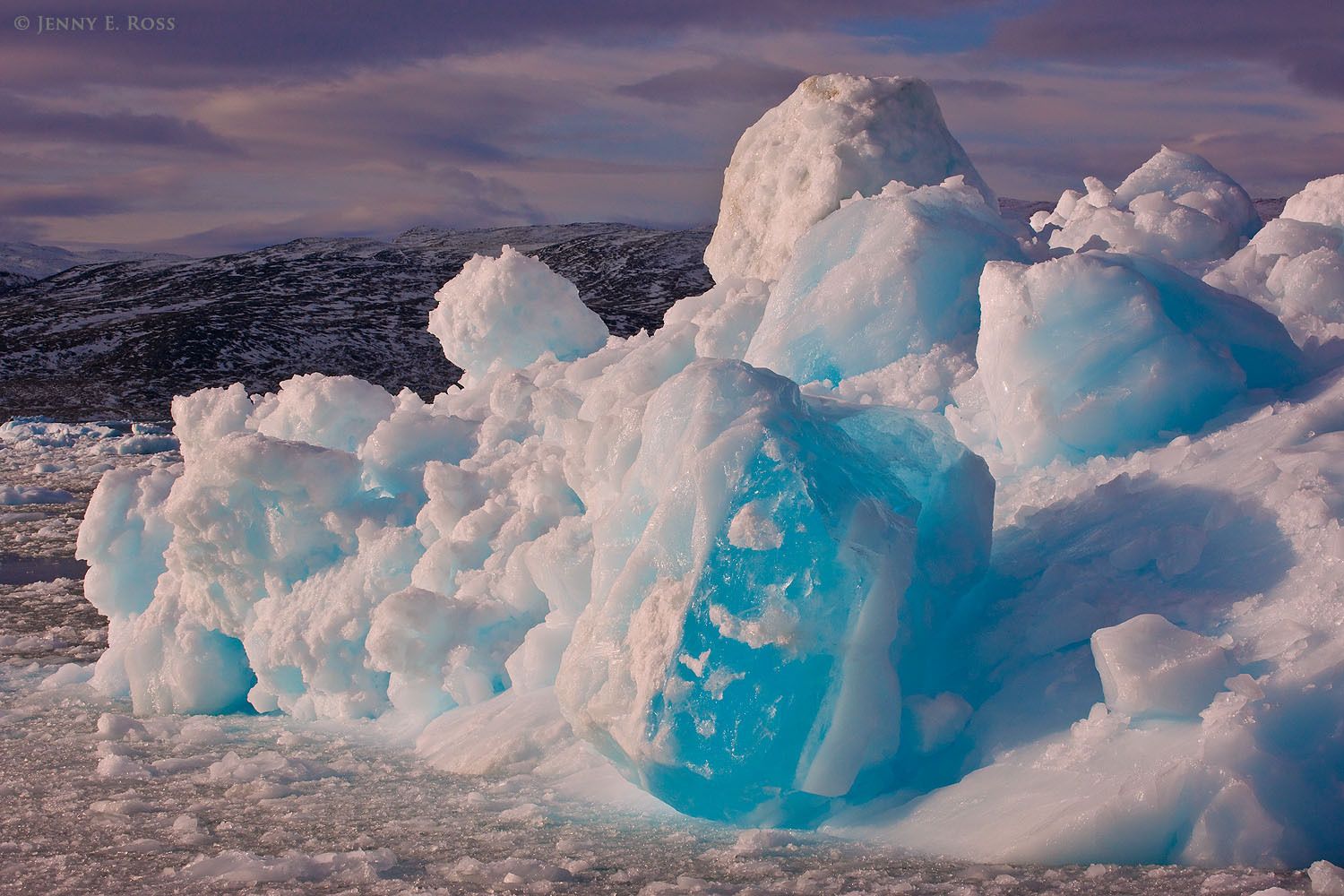
Detail of a disintegrating iceberg near Kangilerngata Sermia Glacier, West Greenland.
-
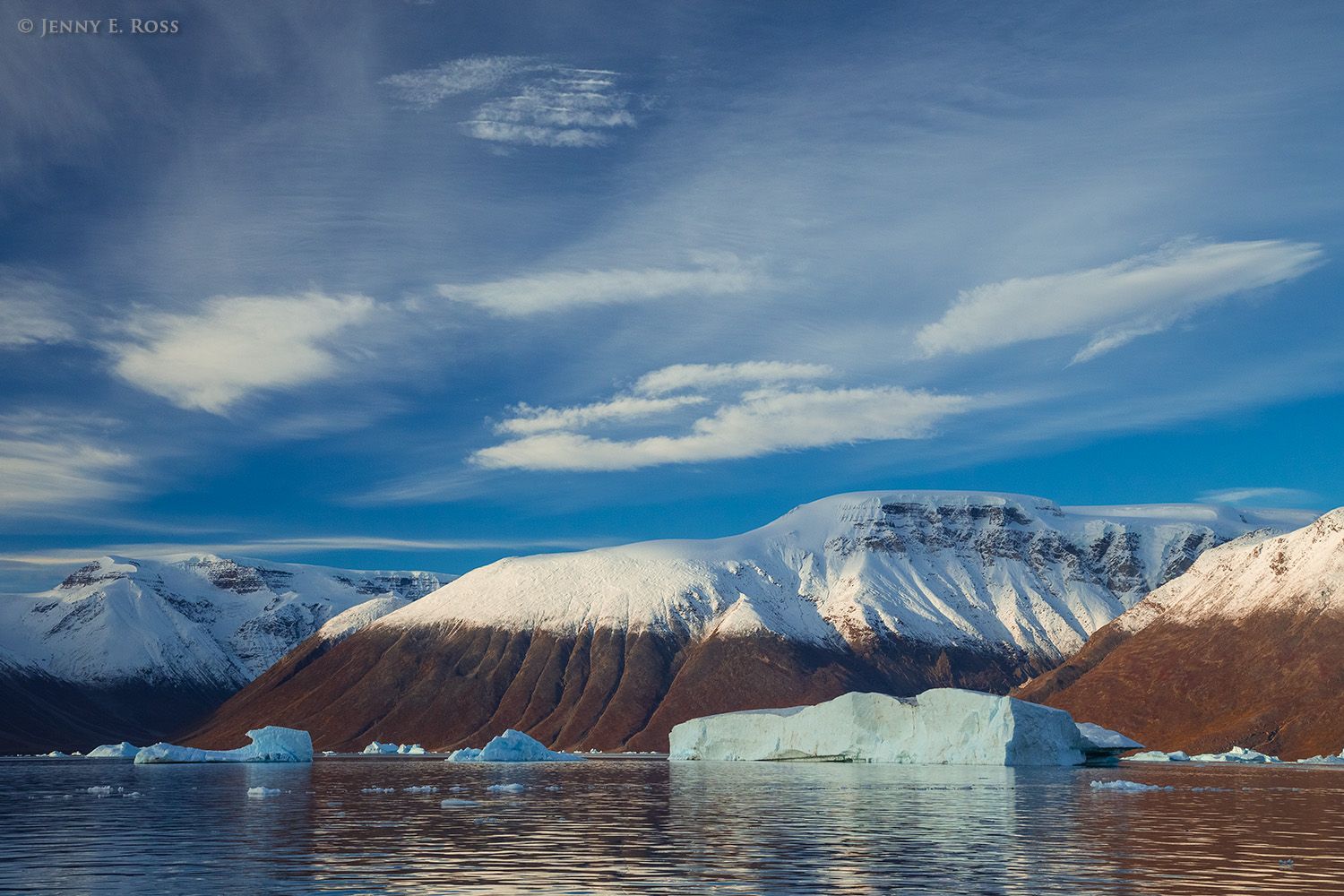
In the early morning, icebergs float near Red Island (Rode O) in Red Fjord (Rode Fjord), Scoresby Sund, East Greenland.
Scoresby Sund, which is connected to the Greenland Sea, has the largest and longest fjord system in the world.
-

Fractured land-fast ice breaking up in late March, southeast Greenland.
-
![Icebergs near Eqip Sermia Glacier in Disko Bugt (Disko Bay), West Greenland]()
Icebergs near Eqip Sermia Glacier in Disko Bugt (Disko Bay), West Greenland
-
![Scoresby Sund, which is connected to the Greenland Sea, has the largest and longest fjord system in the world. Icebergs in Red Fjord (Rode Fjord), Scoresby Sund, East Greenland.]()
Icebergs in Red Fjord (Rode Fjord), Scoresby Sund, East Greenland.
Scoresby Sund, which is connected to the Greenland Sea, has the largest and longest fjord system in the world.
-
![Scoresby Sund, which is connected to the Greenland Sea, has the largest and longest fjord system in the world. Fog-shrouded mountain spires dusted with snow soar above melting icebergs in Ofjord within Scoresby Sund, East Greenland.]()
Fog-shrouded mountain spires dusted with snow soar above melting icebergs in Ofjord within Scoresby Sund, East Greenland.
Scoresby Sund, which is connected to the Greenland Sea, has the largest and longest fjord system in the world.
-
![The Ilulissat Icefjord runs west 40 km (25 miles) from the Greenland Ice Sheet to Disko Bugt (Disko Bay). At the eastern end of the fjord is the Jakobshavn Isbr䟧lacier (aka Sermeq Kujalleq), one of the most productive, fast-moving, and quickly receding glaciers in the Northern Hemisphere. The Ilulissat Icefjord was designated as a UNESCO World Heritage Site in 2004. The Ilulissat Icefjord (also known as Ilulissat Kangerlua or Kangia) in West Greenland, bordered by lichen-encrusted rocky slopes.]()
The Ilulissat Icefjord (also known as Ilulissat Kangerlua or Kangia) in West Greenland, bordered by lichen-encrusted rocky slopes.
The Ilulissat Icefjord runs west 40 km (25 miles) from the Greenland Ice Sheet to Disko Bugt (Disko Bay). At the eastern end of the fjord is the Jakobshavn Isbr䟧lacier (aka Sermeq Kujalleq), one of the most productive, fast-moving, and quickly receding glaciers in the Northern Hemisphere. The Ilulissat Icefjord was designated as a UNESCO World Heritage Site in 2004.
-
![A disintegrating iceberg near the Kangilerngata Sermia glacier, Disko Bugt (Disko Bay), West Greenland.]()
A disintegrating iceberg near the Kangilerngata Sermia glacier, Disko Bugt (Disko Bay), West Greenland.
-
![Following two days of strong foehn winds, numerous large chunks of ice are stranded ashore and grounded in shallow water in Sermilik Fjord, southeast Greenland.]()
Following two days of strong foehn winds, numerous large chunks of ice are stranded ashore and grounded in shallow water in Sermilik Fjord, southeast Greenland.
-
![Sunset illuminates icebergs, produced by the Jakobshavn Isbrae glacier, that are stranded temporarily on Isfjeldbanken at the mouth of the Ilulissat Icefjord in West Greenland. The immense Jakobshavn Isbrae (also known as Sermeq Kujalleq), flows from the Greenland Ice Sheet into the Ilulissat Icefjord and is one of the fastest-moving, most productive, and most quickly receding glaciers in the northern hemisphere. The calved ice eventually moves into the Atlantic Ocean, where it melts and raises sea level. The Ilulissat Icefjord was designated as a UNESCO World Heritage Site in 2004. Huge melting icebergs at Isfjeldbanken (the Iceberg Bank), Ilulissat Icefjord, Disko Bay, West Greenland.]()
Huge melting icebergs at Isfjeldbanken (the Iceberg Bank), Ilulissat Icefjord, Disko Bay, West Greenland.
Sunset illuminates icebergs, produced by the Jakobshavn Isbrae glacier, that are stranded temporarily on Isfjeldbanken at the mouth of the Ilulissat Icefjord in West Greenland. The immense Jakobshavn Isbrae (also known as Sermeq Kujalleq), flows from the Greenland Ice Sheet into the Ilulissat Icefjord and is one of the fastest-moving, most productive, and most quickly receding glaciers in the northern hemisphere. The calved ice eventually moves into the Atlantic Ocean, where it melts and raises sea level. The Ilulissat Icefjord was designated as a UNESCO World Heritage Site in 2004.
-
![Melting icebergs floating near the calving front of the Kangilerngata Sermia Glacier, West Greenland.]()
Melting icebergs floating near the calving front of the Kangilerngata Sermia Glacier, West Greenland.
-
![A large iceberg viewed from both above and below the water surface. East Greenland, Sermilik Fjord.]()
A large iceberg viewed from both above and below the water surface. East Greenland, Sermilik Fjord.
-
![In the early morning, an arched iceberg floats beneath a towering cliff of ancient metamorphosed sedimentary rock near Daugaard-Jensen Glacier within Norvest Fjord in Scoresby Sund, Northeast Greenland National Park, Greenland.]()
In the early morning, an arched iceberg floats beneath a towering cliff of ancient metamorphosed sedimentary rock near Daugaard-Jensen Glacier within Norvest Fjord in Scoresby Sund, Northeast Greenland National Park, Greenland.
-
![Scoresby Sund, which is connected to the Greenland Sea, has the largest and longest fjord system in the world. Iceberg, and cliffs adorned with desert varnish and a dusting of snow, in Ofjord within Scoresby Sund, East Greenland.]()
Iceberg, and cliffs adorned with desert varnish and a dusting of snow, in Ofjord within Scoresby Sund, East Greenland.
Scoresby Sund, which is connected to the Greenland Sea, has the largest and longest fjord system in the world.
-
![Scoresby Sund, which is connected to the Greenland Sea, has the largest and longest fjord system in the world. Icebergs, ancient metamorphosed sedimentary rock, and Daugaard-Jensen Glacier (Daugaard-Jensen Gletscher) are reflected in the still water of Norvest Fjord in Scoresby Sund, Northeast Greenland National Park, Greenland.]()
Icebergs, ancient metamorphosed sedimentary rock, and Daugaard-Jensen Glacier (Daugaard-Jensen Gletscher) are reflected in the still water of Norvest Fjord in Scoresby Sund, Northeast Greenland National Park, Greenland.
Scoresby Sund, which is connected to the Greenland Sea, has the largest and longest fjord system in the world.
-
![Icebergs at Red Island (Rode O) in Red Fjord (Rode Fjord), Scoresby Sund, East Greenland.]()
Icebergs at Red Island (Rode O) in Red Fjord (Rode Fjord), Scoresby Sund, East Greenland.
-
![Detail of an iceberg near Kangilerngata Sermia Glacier, West Greenland]()
Detail of an iceberg near Kangilerngata Sermia Glacier, West Greenland
-
![Scoresby Sund, which is connected to the Greenland Sea, has the largest and longest fjord system in the world. Receding glacier and tabular iceberg, Ofjord, Scoresby Sund, East Greenland.]()
Receding glacier and tabular iceberg, Ofjord, Scoresby Sund, East Greenland.
Scoresby Sund, which is connected to the Greenland Sea, has the largest and longest fjord system in the world.
-
![Scoresby Sund, which is connected to the Greenland Sea, has the largest and longest fjord system in the world. A large tabular iceberg in Rodefjord within Scoresby Sund, East Greenland.]()
A large tabular iceberg in Rodefjord within Scoresby Sund, East Greenland.
Scoresby Sund, which is connected to the Greenland Sea, has the largest and longest fjord system in the world.
-
![Aerial view of tidewater glaciers flowing from the Greenland Ice Sheet into deep fjords of southeast Greenland that are directly connected to the North Atlantic Ocean.]()
Aerial view of tidewater glaciers flowing from the Greenland Ice Sheet into deep fjords of southeast Greenland that are directly connected to the North Atlantic Ocean.
-
![Scoresby Sund, which is connected to the Greenland Sea, has the largest and longest fjord system in the world. Sunset in Hurry Inlet, within Scoresby Sund, East Greenland. Small tundra plants with autumn foliage color the ground red.]()
Sunset in Hurry Inlet, within Scoresby Sund, East Greenland. Small tundra plants with autumn foliage color the ground red.
Scoresby Sund, which is connected to the Greenland Sea, has the largest and longest fjord system in the world.
-
![Scoresby Sund, which is connected to the Greenland Sea, has the largest and longest fjord system in the world. A large tabular iceberg in Rodefjord, within Scoresby Sund, East Greenland.]()
A large tabular iceberg in Rodefjord, within Scoresby Sund, East Greenland.
Scoresby Sund, which is connected to the Greenland Sea, has the largest and longest fjord system in the world.
-
![The colorful glow of a mid-October sunset illuminates icebergs in Murchison Sund, at the northern end of Baffin Bay in Northwest Greenland.]()
The colorful glow of a mid-October sunset illuminates icebergs in Murchison Sund, at the northern end of Baffin Bay in Northwest Greenland.
-
![Scoresby Sund, which is connected to the Greenland Sea, has the largest and longest fjord system in the world. Fog-shrouded red-rock mountains and melting icebergs in Ofjord, Scoresby Sund, East Greenland.]()
Fog-shrouded red-rock mountains and melting icebergs in Ofjord, Scoresby Sund, East Greenland.
Scoresby Sund, which is connected to the Greenland Sea, has the largest and longest fjord system in the world.
-
![Very thin and fractured sea ice covering the ocean in late March near the coast of southeast Greenland.]()
Very thin and fractured sea ice covering the ocean in late March near the coast of southeast Greenland.
-
![Following two days of strong foehn winds, numerous large chunks of ice are stranded ashore and grounded in shallow water in Sermilik Fjord, southeast Greenland.]()
Following two days of strong foehn winds, numerous large chunks of ice are stranded ashore and grounded in shallow water in Sermilik Fjord, southeast Greenland.
-
![Scoresby Sund, which is connected to the Greenland Sea, has the largest and longest fjord system in the world. Icebergs, ancient metamorphosed sedimentary rock, and Daugaard-Jensen Glacier are reflected in the still water of Norvest Fjord in Scoresby Sund, Northeast Greenland National Park, Northeast Greenland.]()
Icebergs, ancient metamorphosed sedimentary rock, and Daugaard-Jensen Glacier are reflected in the still water of Norvest Fjord in Scoresby Sund, Northeast Greenland National Park, Northeast Greenland.
Scoresby Sund, which is connected to the Greenland Sea, has the largest and longest fjord system in the world.
-
![Scoresby Sund, which is connected to the Greenland Sea, has the largest and longest fjord system in the world. Snow-capped mountains incised by glaciers that have disappeared are flanked by giant icebergs in Scoresby Sund, East Greenland.]()
Snow-capped mountains incised by glaciers that have disappeared are flanked by giant icebergs in Scoresby Sund, East Greenland.
Scoresby Sund, which is connected to the Greenland Sea, has the largest and longest fjord system in the world.
-
![A small receding glacier plunges down from the edge of the ice sheet and ends in the narrow canyon it carved but which is no longer filled with ice. The shrinking Greenland Ice Sheet in Northwest Greenland.]()
The shrinking Greenland Ice Sheet in Northwest Greenland.
A small receding glacier plunges down from the edge of the ice sheet and ends in the narrow canyon it carved but which is no longer filled with ice.
-
![At the edge of the Greenland Ice Sheet, a small tidewater glacier funnels ice into the sea in Smith Sund near Ullersuaq (Kap Alexander), northern Baffin Bay, Northwest Greenland.]()
At the edge of the Greenland Ice Sheet, a small tidewater glacier funnels ice into the sea in Smith Sund near Ullersuaq (Kap Alexander), northern Baffin Bay, Northwest Greenland.
-
![Disintegrating icebergs near Gerard de Geer Glacier in Isfjord, within the Kejser Franz Joseph Fjord system, Northeast Greenland National Park, Greenland.]()
Disintegrating icebergs near Gerard de Geer Glacier in Isfjord, within the Kejser Franz Joseph Fjord system, Northeast Greenland National Park, Greenland.
-
![Alpefjord, within the Kong Oscar Fjord system, Northeast Greenland National Park, Greenland. As the ice of Sefstrom Glacier disintegrates and recedes, its surface is increasingly coated with residual dirt and rock debris. Clean blue ice is exposed where icebergs have broken off the glacier face.]()
As the ice of Sefstrom Glacier disintegrates and recedes, its surface is increasingly coated with residual dirt and rock debris. Clean blue ice is exposed where icebergs have broken off the glacier face.
Alpefjord, within the Kong Oscar Fjord system, Northeast Greenland National Park, Greenland.
-
![The full moon rises at sunset behind a portion of the Greenland Ice Sheet that has receded away from the coast of Northwest Greenland. Scars in the rock reveal where a glacier previously scoured a trough from the ice sheet to the sea.]()
The full moon rises at sunset behind a portion of the Greenland Ice Sheet that has receded away from the coast of Northwest Greenland. Scars in the rock reveal where a glacier previously scoured a trough from the ice sheet to the sea.
-
![The skull of a Musk Ox (Ovibos moschatus) lies on the autumn tundra of C. Hoffman Peninsula, Harefjord, Scoresby Sund, East Greenland.]()
The skull of a Musk Ox (Ovibos moschatus) lies on the autumn tundra of C. Hoffman Peninsula, Harefjord, Scoresby Sund, East Greenland.
-
![In some locations not far from the edge of the receding Greenland Ice Sheet in Northwestern Greenland, lichens are profuse on the boulders and rocky ground. A variety of lichen species grow on a sun-lit boulder near the Greenland Ice Sheet in Northwest Greenland.]()
A variety of lichen species grow on a sun-lit boulder near the Greenland Ice Sheet in Northwest Greenland.
In some locations not far from the edge of the receding Greenland Ice Sheet in Northwestern Greenland, lichens are profuse on the boulders and rocky ground.
-
![The northern portion of snow-capped Qeqertarsuaq (Herbert Island) in Murchison Sund, Baffin Bay, Northwest Greenland. Even at mid-day, in October the sun is low in the sky.]()
The northern portion of snow-capped Qeqertarsuaq (Herbert Island) in Murchison Sund, Baffin Bay, Northwest Greenland. Even at mid-day, in October the sun is low in the sky.
-
![Scoresby Sund, which is connected to the Greenland Sea, has the largest and longest fjord system in the world. An enormous tabular iceberg floats by a jagged canyon that was once filled with a glacier in Ofjord within Scoresby Sund, East Greenland.]()
An enormous tabular iceberg floats by a jagged canyon that was once filled with a glacier in Ofjord within Scoresby Sund, East Greenland.
Scoresby Sund, which is connected to the Greenland Sea, has the largest and longest fjord system in the world.
-
![An arched iceberg near Eqip Sermia Glacier in Disko Bugt (Disko Bay), West Greenland.]()
An arched iceberg near Eqip Sermia Glacier in Disko Bugt (Disko Bay), West Greenland.
-
![The Ilulissat Icefjord runs west 40 km (25 miles) from the Greenland Ice Sheet to Disko Bugt (Disko Bay) close to Ilulissat town. At the eastern end of the fjord is the Jakobshavn Isbr䟧lacier (aka Sermeq Kujalleq), one of the most productive, fast-moving, and quickly receding glaciers in the Northern Hemisphere. The Ilulissat Icefjord was designated as a UNESCO World Heritage Site in 2004. Moonrise at Ilulissat Icefjord (also known as Ilulissat Kangerlua or Kangia) in West Greenland.]()
Moonrise at Ilulissat Icefjord (also known as Ilulissat Kangerlua or Kangia) in West Greenland.
The Ilulissat Icefjord runs west 40 km (25 miles) from the Greenland Ice Sheet to Disko Bugt (Disko Bay) close to Ilulissat town. At the eastern end of the fjord is the Jakobshavn Isbr䟧lacier (aka Sermeq Kujalleq), one of the most productive, fast-moving, and quickly receding glaciers in the Northern Hemisphere. The Ilulissat Icefjord was designated as a UNESCO World Heritage Site in 2004.
-
![In the early morning, icebergs at Daugaard-Jensen Glacier (Daugaard-Jensen Gletscher) are reflected in the calm water of Norvest Fjord in Scoresby Sund, Northeast Greenland National Park, Greenland.]()
In the early morning, icebergs at Daugaard-Jensen Glacier (Daugaard-Jensen Gletscher) are reflected in the calm water of Norvest Fjord in Scoresby Sund, Northeast Greenland National Park, Greenland.
-
![Ice detail at the calving front of the Eqip Sermia glacier, West Greenland.]()
Ice detail at the calving front of the Eqip Sermia glacier, West Greenland.
-
![Ice detail at the receding calving front of the Eqip Sermia glacier, West Greenland.]()
Ice detail at the receding calving front of the Eqip Sermia glacier, West Greenland.
-
![Ice detail in the ablation zone at the Eqip Sermia glacier, West Greenland.]()
Ice detail in the ablation zone at the Eqip Sermia glacier, West Greenland.
-
![Brash ice and the calving front of the Eqip Sermia Glacier, West Greenland]()
Brash ice and the calving front of the Eqip Sermia Glacier, West Greenland
-
![A disintegrating iceberg is reflected in the still water of Sermilik Fjord, southeast Greenland.]()
A disintegrating iceberg is reflected in the still water of Sermilik Fjord, southeast Greenland.
-
![A receding glacier and pinnacle peaks are reflected in the still water of Tasermiut Fjord, South Greenland.]()
A receding glacier and pinnacle peaks are reflected in the still water of Tasermiut Fjord, South Greenland.
-
![The pink glow of a mid-October sunrise illuminates the southern end of Qeqertarsuaq (Herbert Island) and icebergs in Murchison Sund, Baffin Bay, Northwest Greenland.]()
The pink glow of a mid-October sunrise illuminates the southern end of Qeqertarsuaq (Herbert Island) and icebergs in Murchison Sund, Baffin Bay, Northwest Greenland.
-
![Boulders, gravel, and sand of a terminal moraine lie far from the receding glacier that left them behind in Alpefjord, Kong Oscar Fjord system, Northeast Greenland National Park, Greenland.]()
Boulders, gravel, and sand of a terminal moraine lie far from the receding glacier that left them behind in Alpefjord, Kong Oscar Fjord system, Northeast Greenland National Park, Greenland.
-
![Large icebergs calved from Nordenskiold Glacier and small fragments of rapidly-melting sea ice float beneath towering cliffs of metamorphosed and deformed sedimentary rock in the most southerly arm of the Kejser Franz Joseph Fjord system within Northeast Greenland National Park. The dramatic striated rock formations in this region are ancient, and range in age from 1.75 to 3.1 billion years old. Some of the banded iron formations – reddish stripes in the cliff – may date from Earth’s “Great Oxygenation Event” beginning about 2.4 billion years ago, when biologically-produced free oxygen first began to accumulate in the atmosphere. Ancient cliffs & icebergs in Kejser Franz Joseph Fjord System at Nordenskiold Glacier, Northeast Greenland National Park, Greenland.]()
Ancient cliffs & icebergs in Kejser Franz Joseph Fjord System at Nordenskiold Glacier, Northeast Greenland National Park, Greenland.
Large icebergs calved from Nordenskiold Glacier and small fragments of rapidly-melting sea ice float beneath towering cliffs of metamorphosed and deformed sedimentary rock in the most southerly arm of the Kejser Franz Joseph Fjord system within Northeast Greenland National Park. The dramatic striated rock formations in this region are ancient, and range in age from 1.75 to 3.1 billion years old. Some of the banded iron formations – reddish stripes in the cliff – may date from Earth’s “Great Oxygenation Event” beginning about 2.4 billion years ago, when biologically-produced free oxygen first began to accumulate in the atmosphere.
-
![A fog-shrouded receding glacier lies deep within the canyon it carved in Alpefjord, Kong Oscar Fjord system, Northeast Greenland National Park, Greenland.]()
A fog-shrouded receding glacier lies deep within the canyon it carved in Alpefjord, Kong Oscar Fjord system, Northeast Greenland National Park, Greenland.
-
![Iceberg and autumn tundra in the rain on the coast of Paradisdalen, Kejser Franz Josef Fjord, Northeast Greenland National Park, Greenland.]()
Iceberg and autumn tundra in the rain on the coast of Paradisdalen, Kejser Franz Josef Fjord, Northeast Greenland National Park, Greenland.
-
![A huge arched iceberg near Gerard de Geer Glacier, in Isfjord within the Kejser Franz Joseph Fjord system, East Greenland National Park, Greenland.]()
A huge arched iceberg near Gerard de Geer Glacier, in Isfjord within the Kejser Franz Joseph Fjord system, East Greenland National Park, Greenland.
-
![Alpefjord, within the Kong Oscar Fjord system, Northeast Greenland National Park, Greenland. As the ice of Sefstrom Glacier melts and recedes, its surface is increasingly coated with residual dirt and rock debris. Clean blue ice is exposed where icebergs have broken off the glacier face.]()
As the ice of Sefstrom Glacier melts and recedes, its surface is increasingly coated with residual dirt and rock debris. Clean blue ice is exposed where icebergs have broken off the glacier face.
Alpefjord, within the Kong Oscar Fjord system, Northeast Greenland National Park, Greenland.
-
![The water in Ymer O is naturally tinted pink by run-off from the eroding iron-rich rocks that surround and underlie the lake. Lake Ymer O cradled by mountains in Blomsterbugten, Kejser Franz Joseph Fjord, Northeast Greenland National Park, Greenland]()
Lake Ymer O cradled by mountains in Blomsterbugten, Kejser Franz Joseph Fjord, Northeast Greenland National Park, Greenland
The water in Ymer O is naturally tinted pink by run-off from the eroding iron-rich rocks that surround and underlie the lake.
-
![A melting iceberg in brash ice, with a distant rainstorm approaching, near Kangilerngata Sermia Glacier, West Greenland.]()
A melting iceberg in brash ice, with a distant rainstorm approaching, near Kangilerngata Sermia Glacier, West Greenland.
-
![A large iceberg with very unusual stripes containing layers of ancient sediments, in Red Fjord (Rode Fjord), Scoresby Sund, East Greenland.]()
A large iceberg with very unusual stripes containing layers of ancient sediments, in Red Fjord (Rode Fjord), Scoresby Sund, East Greenland.
-
![Intensely blue iceberg and shoreline hills dusted with snow near Kangilerngata Sermia Glacier, West Greenland.]()
Intensely blue iceberg and shoreline hills dusted with snow near Kangilerngata Sermia Glacier, West Greenland.
-
![Scoresby Sund, which is connected to the Greenland Sea, has the largest and longest fjord system in the world. Icebergs, ancient metamorphosed sedimentary rock, and Daugaard-Jensen Glacier (Daugaard-Jensen Gletscher) are reflected in the still water of Norvest Fjord in Scoresby Sund, Northeast Greenland National Park, Northeast Greenland.]()
Icebergs, ancient metamorphosed sedimentary rock, and Daugaard-Jensen Glacier (Daugaard-Jensen Gletscher) are reflected in the still water of Norvest Fjord in Scoresby Sund, Northeast Greenland National Park, Northeast Greenland.
Scoresby Sund, which is connected to the Greenland Sea, has the largest and longest fjord system in the world.
-
![A melting iceberg with an unusual pitted structure floats near the calving front of the Kangilerngata Sermia Glacier in West Greenland.]()
A melting iceberg with an unusual pitted structure floats near the calving front of the Kangilerngata Sermia Glacier in West Greenland.
-
![Disintegrating icebergs near the Kangilerngata Sermia Glacier, West Greenland.]()
Disintegrating icebergs near the Kangilerngata Sermia Glacier, West Greenland.
-
![Detail of melting brash ice floating near Kangilerngata Sermia Glacier, West Greenland.]()
Detail of melting brash ice floating near Kangilerngata Sermia Glacier, West Greenland.

